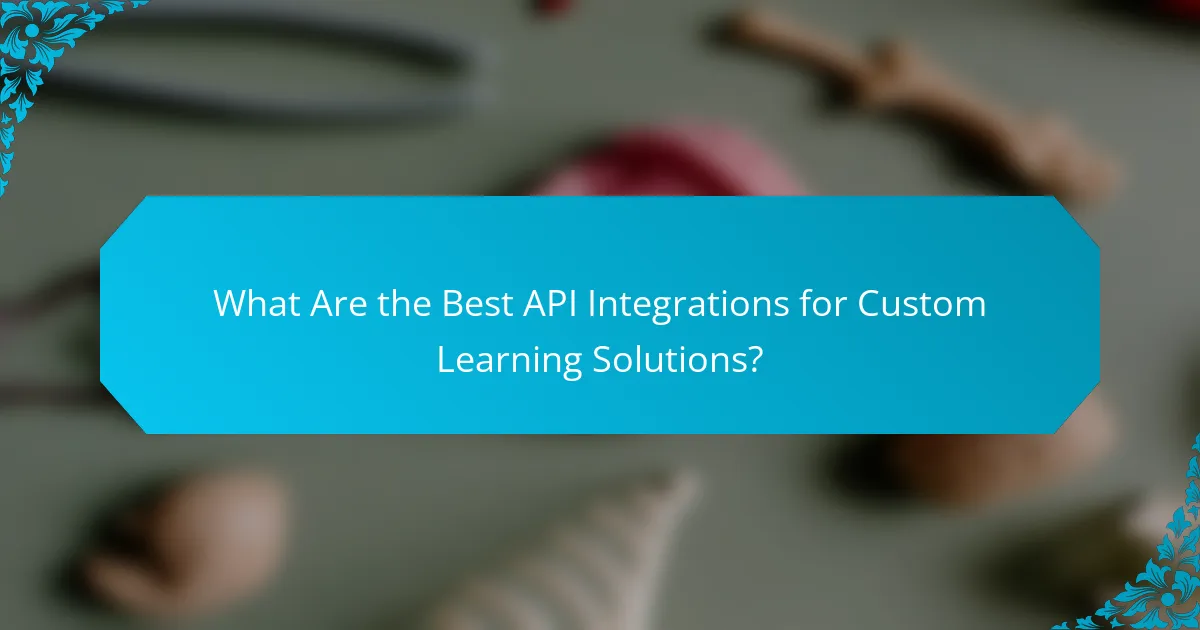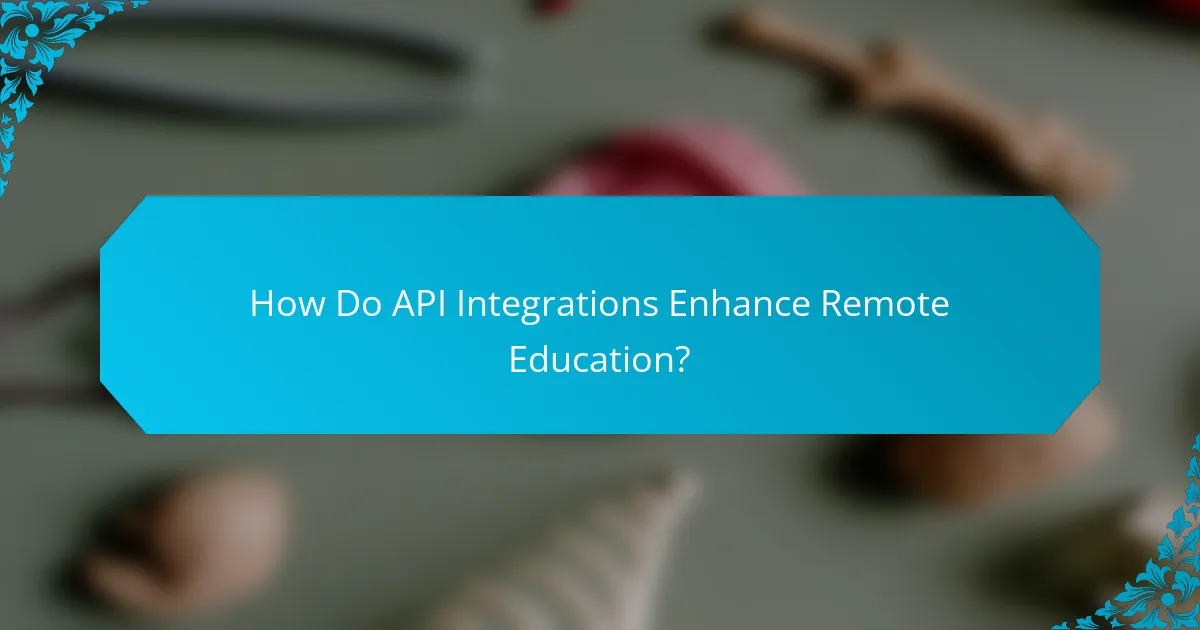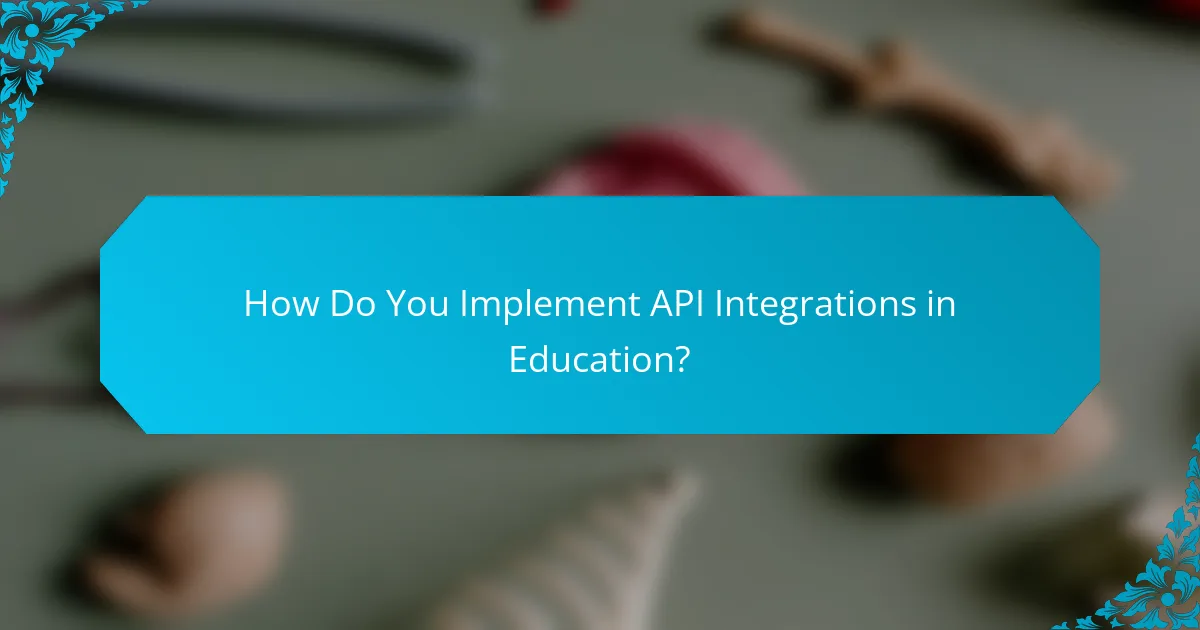API integrations play a crucial role in developing custom learning solutions that enhance flexibility and functionality in remote education. By facilitating seamless data exchange between various educational platforms, these integrations create a more cohesive learning experience, ensuring that both students and educators have real-time access to vital resources. This adaptability not only improves engagement but also makes education more inclusive and tailored to individual needs.

What Are the Best API Integrations for Custom Learning Solutions?
The best API integrations for custom learning solutions enhance flexibility and functionality in remote education. They allow educators and institutions to tailor their learning environments to meet specific needs, improving engagement and accessibility.
Google Classroom API
The Google Classroom API enables developers to integrate Google Classroom features into their applications. This API allows for the creation and management of classes, assignments, and rosters, making it easier to streamline communication between educators and students.
When using the Google Classroom API, consider the authentication process and the need for proper permissions. Ensure that your application complies with Google’s data privacy policies to protect user information.
Moodle API
Moodle’s API provides a robust framework for integrating various functionalities into custom learning solutions. It supports course management, user authentication, and grading systems, making it a popular choice among educational institutions.
To effectively utilize the Moodle API, familiarize yourself with its extensive documentation and available endpoints. This will help you leverage its capabilities for creating personalized learning experiences and managing course content efficiently.
Canvas LMS API
The Canvas LMS API allows developers to access and manipulate data within the Canvas Learning Management System. It supports features like course creation, user enrollment, and assignment submissions, facilitating seamless integration with other educational tools.
When implementing the Canvas API, pay attention to rate limits and data handling practices. Properly managing API requests can enhance performance and ensure a smooth user experience.
Blackboard API
The Blackboard API offers a comprehensive set of tools for integrating with the Blackboard learning platform. It provides access to course materials, user data, and assessment tools, enabling tailored educational experiences.
Be mindful of the security protocols required by the Blackboard API. Implementing OAuth for authentication will help safeguard user data while allowing your application to interact with Blackboard services effectively.
Edmodo API
The Edmodo API facilitates integration with the Edmodo platform, which is widely used for K-12 education. It allows developers to access features such as class management, assignment tracking, and communication tools.
To maximize the benefits of the Edmodo API, ensure that your application aligns with the platform’s user engagement strategies. This can enhance student interaction and improve overall learning outcomes.

How Do API Integrations Enhance Remote Education?
API integrations significantly enhance remote education by enabling seamless data exchange between various educational platforms and tools. This connectivity allows for a more cohesive learning experience, ensuring that students and educators have access to the latest information and resources in real-time.
Real-time data synchronization
Real-time data synchronization ensures that all educational tools are updated simultaneously, providing accurate and current information. For instance, when a student submits an assignment, the grades can instantly reflect in the learning management system (LMS), allowing for immediate feedback.
To implement effective data synchronization, consider using APIs that support webhooks or polling mechanisms. This approach minimizes delays and ensures that users are always working with the most relevant data, which is crucial in a fast-paced learning environment.
Personalized learning experiences
API integrations facilitate personalized learning experiences by allowing platforms to share data about student progress and preferences. For example, an LMS can integrate with an assessment tool to tailor quizzes based on individual student performance, enhancing engagement and effectiveness.
To maximize personalization, choose APIs that allow for detailed analytics and reporting. This data can help educators identify learning gaps and adjust content accordingly, ultimately supporting diverse learning styles and needs.
Improved communication tools
Improved communication tools through API integrations enhance collaboration between students and educators. For instance, integrating messaging platforms with LMS can streamline communication, allowing students to ask questions and receive timely responses without leaving the learning environment.
When selecting communication tools, prioritize those that offer features like notifications and group chats. These functionalities can foster a sense of community and ensure that all participants are engaged and informed throughout the learning process.

What Are the Benefits of Flexible Learning Solutions?
Flexible learning solutions provide significant advantages such as enhanced accessibility, tailored learning experiences, and the ability to scale for a variety of learners. These benefits make education more inclusive and adaptable to individual needs and circumstances.
Increased accessibility
Flexible learning solutions increase accessibility by allowing learners to engage with educational content from anywhere at any time. This is particularly beneficial for individuals with disabilities, those in remote areas, or anyone balancing work and study.
For example, online courses can be accessed via smartphones or computers, enabling students to learn at their own pace and convenience. Institutions should ensure that their platforms comply with accessibility standards, such as WCAG, to cater to all learners effectively.
Customizable learning paths
Customizable learning paths allow students to tailor their educational experiences according to their interests, skills, and career goals. This personalization can lead to higher engagement and better learning outcomes.
For instance, learners can select specific modules or topics that align with their professional aspirations, enabling them to focus on what is most relevant. Educational providers should offer a variety of options and support to help students create their unique learning journeys.
Scalability for diverse learners
Scalability in flexible learning solutions means that educational programs can accommodate a wide range of learners, from beginners to advanced students. This adaptability is crucial for institutions aiming to serve diverse populations.
For example, a single online course can support hundreds of students simultaneously, allowing for a broader reach without compromising quality. Institutions should invest in robust technology and resources to ensure that their platforms can handle varying numbers of participants effectively.

What Criteria Should You Consider When Choosing API Integrations?
When selecting API integrations, focus on compatibility, scalability, and support. These criteria ensure that the integration will work seamlessly with your existing systems, can grow with your needs, and is backed by comprehensive documentation and assistance.
Compatibility with existing systems
Compatibility is crucial when choosing API integrations, as it determines how well the new solution will work with your current technology stack. Assess whether the API supports the programming languages and platforms you are already using. For instance, if your system is built on Java, ensure the API provides robust Java libraries.
Additionally, consider the ease of integration. Look for APIs that offer clear guidelines and tools to facilitate a smooth connection with your existing systems. This can save time and reduce the risk of errors during implementation.
Scalability and performance
Scalability refers to the API’s ability to handle increased loads as your user base grows or as your application demands change. Choose APIs that can accommodate growth without significant performance degradation. For example, an API that can manage thousands of requests per second is preferable for a rapidly expanding online education platform.
Performance metrics such as response time and uptime are also critical. Aim for APIs that consistently deliver low latency, ideally in the low tens of milliseconds, and have a strong track record of reliability, with uptime percentages above 99.9%.
Support and documentation
Robust support and thorough documentation are essential for effective API integration. Look for APIs that provide extensive resources, including tutorials, FAQs, and community forums. This can significantly ease the learning curve and troubleshooting process.
Additionally, consider the availability of customer support. APIs with responsive support teams can help resolve issues quickly, minimizing downtime. Check for multiple support channels, such as email, chat, or phone, to ensure you can get assistance when needed.

How Do You Implement API Integrations in Education?
Implementing API integrations in education involves connecting various software applications to enhance learning experiences and streamline administrative tasks. This process requires careful planning, assessment of existing systems, and a clear understanding of the educational goals to be achieved.
Step 1: Assess current infrastructure
Begin by evaluating your existing educational technology infrastructure, including Learning Management Systems (LMS), student information systems, and communication tools. Identify the strengths and weaknesses of these systems to determine how API integrations can fill gaps or improve functionality.
Consider factors such as compatibility with current software, user experience, and data security. For instance, if your LMS supports RESTful APIs, it can facilitate smoother integration with third-party applications, enhancing flexibility in remote education.
Engage stakeholders, including educators and IT staff, to gather insights on current challenges and desired features. This collaborative approach ensures that the integration aligns with the needs of both educators and learners, ultimately leading to a more effective implementation strategy.
